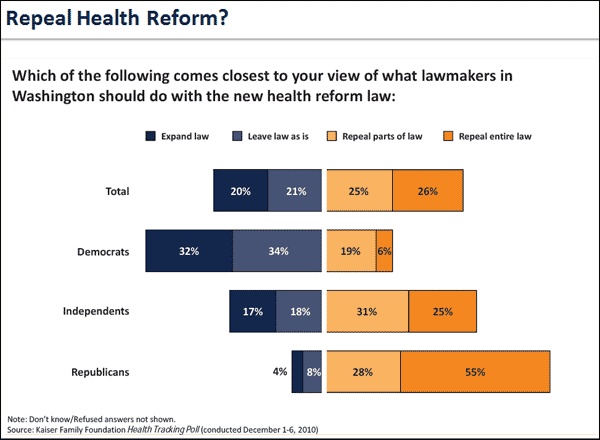Pulling It Together: Repeal
The House will soon vote to repeal the health reform law, the Senate won’t, and the President would veto it if they did. So what does a House vote for repeal mean?
It is, of course, a campaign promise kept to the political right. It is also a signal from the Republican leadership that they plan to continue to use opposition to the health reform law as a rallying point for their political base. Our polling shows that Republicans have opposed the law since well before its passage, and its critics have made it a symbol of deeper discontent with Washington and the federal government that resonates strongly with Republican voters.
It is possible that repeal in the House will also embolden governors who have staked out a position against the law to drag their feet; although most states whose governors are opposing the law are still moving forward to implement it. Ultimately, governors with a strong ideological opposition to the law will have to weigh that opposition against the substantial new federal funding the law will bring to their states in the form of dollars for subsidies for the uninsured, expanded Medicaid coverage, and grant dollars for a variety of new programs. Usually money trumps ideology at the state level, where politics are generally more pragmatic than they are in Washington; but the recent elections brought substantial changes to many state legislatures, and the patterns I saw when I was in state government may or may not be a good predictor of behavior this time. If states don’t implement the law, elements of it — such as the exchanges and subsidies — will be implemented by the federal government instead. Faced with this choice, some Republican governors may seek to implement more conservative-leaning versions of the law, which they can brand as their own.
Some observers believe repeal in the House will actually flip the advantage to the Democrats by underscoring the popular benefits the public will lose if the law were to be repealed. A repeal debate could enable the Democrats to shift the focus from “Obamacare” as a symbol of the things people don’t like about the federal government and how Washington works to what the law actually does and what people will lose if it disappears; advantage Democrats, or so the argument goes.
Often overlooked in this focus on Washington tactics are these two points:
First, while the public clearly continues to be split on the law, there is no groundswell of support for outright repeal. In our December poll, 26% of the public favored full repeal, 25% favored repealing some parts of the law and keeping other parts, 21% favored keeping the law as it is, and 20% favored expanding the law. Another way of looking at it: almost as many people (20%) favor expanding it as favor repealing it entirely (26%). Not surprisingly, 55% of Republicans want to repeal it entirely and 32% of Democrats want to expand it.

Second, a likely result of a repeal vote in the House will be even greater public confusion. In our December tracking poll, we found that 43% of the public said they were still “confused” about the law (confusion was the public’s dominant feeling — 30% said they were “angry” and 33% said they were “enthusiastic”). How many people will think the law has actually been repealed (when it has not) if a repeal measure passes the House? We will test this in an upcoming tracking poll, but there is a real burden on the news media to explain clearly what has and has not happened (and that implementation of the law is continuing).Potentially more important than the House repeal vote are the efforts expected to target and defund parts of the law or to slow implementation. How successful these efforts will be remains to be determined. Targeted defunding is itself a complex topic involving disentangling the different kinds of funding authority in the law (for example, mandatory appropriations, entitlements, and tax changes written into the statute vs. discretionary funding requiring future congressional action) and an equally complex web of potential legislative strategies. In general, however, defunding through the budget process cannot eliminate the law’s main benefits, such as the insurance reforms, Medicaid expansion, and tax credits to help people afford insurance coverage. But, it can reduce the number of staff in federal agencies available to work on implementation. Frequent oversight hearings are also expected in the House and could create a continuing climate of confrontation around the law.
What the repeal vote in the House demonstrates is how changing political circumstances can alter the policy landscape, sometimes rapidly. And it does not require high level political analysis to figure out the next big external event that will affect implementation of the law — the 2012 presidential election. If the president is re-elected, implementation is likely to move forward pretty much as the statute contemplates; and if he is not, bigger changes in direction are possible.
In the short term, with the main benefits of the legislation not yet implemented, opponents of the law have an opportunity to press their case. However, once its main provisions are in place in 2014, repeal will be viewed as taking away tangible benefits tens of millions of people have and value. There is an old maxim about our political system that benefits, once conferred, cannot be taken away. Unless that fundamental law of American politics has itself been repealed, after 2014, discussion is likely to shift to improving and expanding the benefits and protections the law provides, not repealing them.
